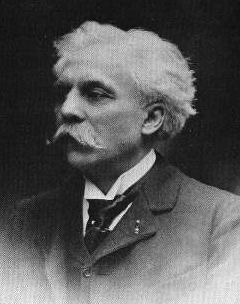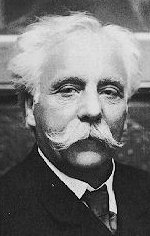 Gabriel
Fauré (1845-1924)
Gabriel
Fauré (1845-1924) Gabriel
Fauré (1845-1924)
Gabriel
Fauré (1845-1924)He trained at the Ecole Niedermeyer (1854-65) as organist and choirmaster,
coming under the influence of Saint-Saëns and his circle while working
as a church musician (at Rennes, 1866-70; St. Sulpice, 1871-3; the Madeleine,
from 1874) and giving lessons. Though he met Liszt and was fascinated by
Wagner, he sought a distinctive style in his piano pieces and numerous
songs, which had to be composed during summer holidays. Recognition came
slowly owing to the modernity of his music. In 1892 he became national
inspector of of the provincial conservatories, and in 1896 chief organist
at the Madeleine and composition professor at the Conservatoire, where
his pupils included Ravel, Koechlin, Roger-Ducasse, Enescu and Nadia Boulanger;
from 1905 to 1920 he was the Conservatoire's resolute and influential director,
becoming celebrated for the vocal and chamber masterpieces he produced
until his death.

Fauré's stylistic development can be traced from the sprightly
or melancholy song settings of his youth to the bold, forceful late instrumental
works, traits including a delicate combination of extended tonality and
modality, rapid modulations to remote keys and continuously unfolding melody.
Widely regarded as the greatest master of French song, he produced six
important cycles (notably the novel op. 61) and three collections each
of twenty pieces (1879, 1897, 1908). In chamber music he enriched all the
genres he attempted, while his works for piano (chiefly nocturnes, barcarolles
and impromptus) embody the full scope of his stylistic evolution. Among
his few large-scale works, the popular and delicately written Requiem op.
48 and the "song opera" Pénélope (1913) are noteworthy.
(Hear an excerpt from Pelléas et Mélisande)